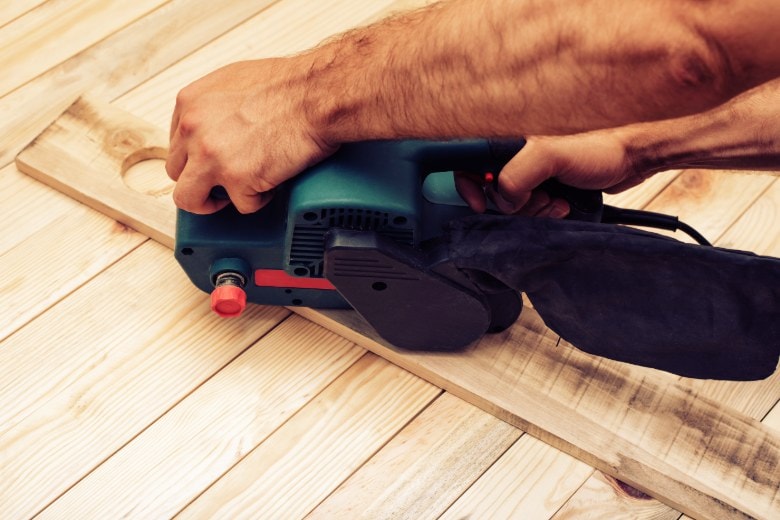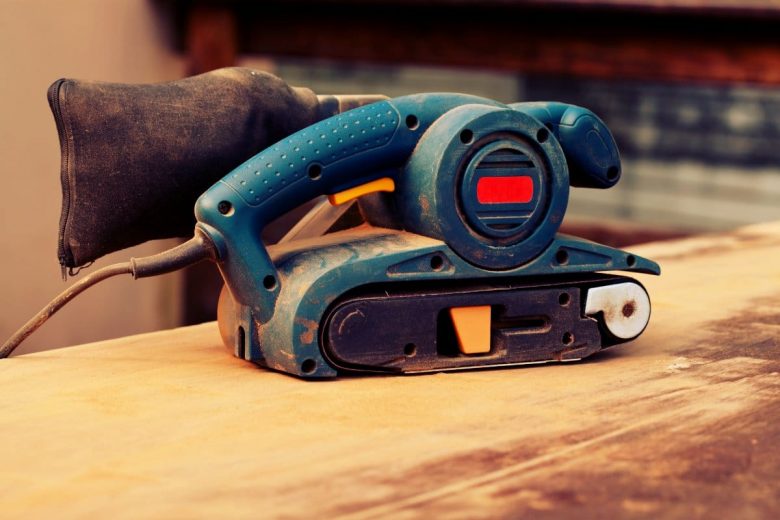If you just want a quick answer, Makita 9403 is the best woodworking belt sander you can buy. Read on to find out why.
Many woodworkers make the mistake of overlooking belt sanders when stocking their shop with power tools. Beginners may feel intimidated by belt sanders since they are capable of removing large amounts of material so quickly. But, as we all know, sanding can be extremely grueling. If you intend to work on large projects, investing in a good belt sander is a must.
This article will explain what you should consider when shopping for a belt sander. We will also review five of the best belt sanders of 2024 so that you don’t spend your hard-earned money on a low-quality tool.
Top belt sanders compared:
Belt Sander Basics
A belt sander uses abrasive belts instead of disks or sheets. This allows the user to sand with the grain at all times instead of the circular motion found on disc and orbiting sanders.
Linear sanding with the grain provides smoother results. When you sand cross-grain, the abrasive will tend to leave small gouges in the wood surface. These blemishes can be seen especially under stains.
The motors on belt sanders will be more powerful than those found on even the top-rated random orbital sanders. This increased power equates to shorter work times.
A larger motor and linear sanding motion will also let you work with larger grit abrasives that can remove material faster. You will also need less force to smooth out the wood surface.
Belt sanders will require the use of both hands in order to maintain proper control.
You may need a little more practice to master this type of sander than a disc or orbital sander.
What are belt sanders best for?
A belt sander excels with rough timber. These tools will help you level and smooth boards faster than other sanding techniques or hand planning.
They can also be used for taking wood down to a curved scribed line as well as larger curved edges.
The only sanding work belt sanders fair poorly with is detailed sanding. You may also struggle to work on smaller curves.

Buying A Belt Sander: Things To Consider
Hand-Held vs Stationary
A belt sander will make use of a pair of rollers and a sanding belt to remove material. There are differences between designs, including:
Hand-Held Belt Sander
You will find these more compact. That means less room to store and operate. It is portable, but you sacrifice some control.
Belt width varies, but you can encounter thinner belts with hand-held products. Dust collection is limited to a hose attachment with this type of belt sander.

Pros
- These are portable
- Work on larger boards
- You will usually pay less
Cons
- More difficult to control
- Less accurate
Stationary Belt Sander
A stationary design lets you take advantage of table support. That provides more accurate results, including with beveled edges. You need to take the wood to the tool, limiting board size for efficiency and safety.
Wider belts are easier to find on these products, as they offer better control. The table design allows for more powerful dust extraction on a stationary belt sander.

Pros
- Easy to control
- More accurate results
- More accessories
Cons
- Lacks mobility
- Limited work capacity
Motor Power
Belt sander motors can range anywhere from 4 amps to over 10 amps. I would recommend buying the largest motor you can afford. This will give you a sander that can handle tougher jobs without taking forever to finish. It can also help save wear on the belt as well as the motor itself.
Design Comfort
Ergonomic design is vitally important when using a belt sander. Some projects require long hours of sanding, and a poorly designed belt sander can put a lot of strain on your body, especially your hands.
Look for ergonomic handle designs that offer some type of cushioning or materials that help absorb vibration. I’ve discovered that larger handhold points provide me with longer relief than smaller handholds.
Variable Speed Control
Speed adjustments will provide you with more control while sanding. Belt sanders can sand down wood quickly. Speed control will let you slow down the belt on softer woods or on surfaces that require less material to be removed.
Conversely, speeding up a high-grit belt will allow you to take a rough board down with minimal effort and time.
Dust collection
Sanding produces a lot of dust. Belt sanders, in particular, can generate large amounts of debris, and that material needs to go somewhere. Proper dust removal keeps the wood particles from collecting on the project surface or in your lungs!
Dust ports with proper connection dimensions for your shop vac or ductwork will make attaching and detaching simple while providing a good seal.
Top-Rated Belt Sander Reviews
1. Best Belt Sander for The Money: Makita 9403

- Low noise (84dB) for operator comfort
- 4" wide belt with a speed of 1,640 ft./min. for fast material removal
- Labyrinth construction seals and protects motor and bearings from dust and debris for longer tool life
OVERVIEW
Makita is known for making quality for a bit more money than similar models from other manufacturers. A smaller footprint of the Makita 9403 Belt Sander makes this device easier to carry and store, which can be an advantage if you have limited room in your work area.
PROS
- A four-inch belt offers more abrasive for larger workpieces. That would have saved me time over the three-inch belt on my first belt sander.
- This model has a decibel level of about 84. That makes it less noisy than many belt sanders on the market.
- An 11-amp motor will provide plenty of power to sand through the material, including rough-milled lumber that is uneven.
CONS
- This particular model has only one speed. The lack of speed adjustment makes it less versatile than other models. This can cause more control issues for those using the belt sander for the first time.
- Using a four-inch belt can be an issue if you work on small pieces of wood. It can also create sanding problems if you are trying to work on pieces with tight curves.
2. The Runner Up: Makita 9903 3″ X 21″ Belt Sander

- Powerful 8.8 AMP motor; only 85dB
- Variable speed control dial (690 -1,440 ft./min.) to match the speed to the application
- Auto-tracking belt system tracks belt without adjustment
OVERVIEW
A low noise level on this 8.8 amp model allows it to run with less noise while providing adequate power to the belt. It also has a low profile, a feature that helps provide more balance.
PROS
- Unlike the previous Makita model reviewed above, this model provides users with variable speed control. That provides it with increased versatility over the single-speed model.
- A flush design on the body allows this belt sander to reach into corner areas that other belt sanders would struggle with.
- It has a dust collection bag that appears to be larger than those found on some belt sanders. The extra space will allow you to run this sander longer between cleanouts.
CONS
- The front hand holding point is not very ergonomic. That can make it more difficult to grasp and to hold onto during operation.
- A one-year warranty seems a bit short, considering the price point of this particular model. When combined with its import status, the limited warranty may affect customer confidence in a negative manner.
3. Best Budget Belt Sander: WEN 6321

- 7-amp motor rotates the belt at over 13 feet per second
- Compact design weighs in at a mere six pounds to limit the fatigue of the user
- Includes a detachable dust bag to minimize clean-up
OVERVIEW
The 6321 measures approximately 12 inches L x 6.0 inches W x 6.50 inches H and weighs 6.2 pounds. That size will make the belt sander easy to control, and the weight means that you should not become fatigued.
Its electric motor lists at a 7.0 amp rating. That drives the belt at 820 Feet Per Minute (FPM) under no-load conditions. You will need to bear down heavily on the sander as you work to cause any slowdown in belt speeds.
It includes a detachable dust bag and has a simple design that beginners can master quickly.
PROS
- The price point of this product puts it within the range of most woodworkers. Casual hobbyists and DIYers will appreciate a low-cost option for this type of power tool.
- The materials used for construction are lightweight. It weighs about six pounds, which is workable for most users reading this product review.
- A 7.0 amp rating indicates a long operating time before overheating. It stands out as you will likely finish sanding most surfaces before that would be an issue.
CONS
- A three-inch-wide sanding belt will take longer to cover large boards. You will need more passes and movement to cover the surfaces on a project than you would with a four-inch sanding belt.
- Tracking can be an issue if you use the sander often. It has an adjustment knob just for tracking, and you might have to stop for adjustments multiple times on larger pieces.
4. Best Benchtop Belt Sander: WEN 6502T

- Two-in-one sanding machine includes both a 4-by-36 inch belt and a 6-by-6 inch disc
- Belt tilts anywhere from 0 to 90 degrees
- Sturdy cast iron base prevents any heavy vibrations
OVERVIEW
WEN’s 6502T measures approximately 22 inches L x 11 inches W x 12.5 inches H. It weighs just under 38 pounds (listed at 37.9). That makes this combination belt/disc sander compact and lightweight, both being features hobbyists can appreciate.
A 4.3 amp electric motor drives the sanding surfaces on this product. It can generate up to 3,600 Rotations Per Minute (RPMs) without a load. Those may not be the highest rates for a benchtop belt sander, but they will suffice for most beginner and intermediate woodworkers.
A small tabletop supports wood on both the disc and belt stations. The belt can tilt up to 90 degrees for flat beveling on the edge of your lumber.
PROS
- WEN uses cast iron as the base material. That provides increased weight, which will limit vibration transfer while increasing durability.
- The tilt range goes between 0 and 90 degrees. That will cover any bevel angle that needs to be applied or smoothed out along the edge of your projects.
- Its tensioning levers are easy to use. They keep the belt in place and make changing between sanding grits quick and simple to do.
CONS
- It uses a 4.3 amp electric motor, which might struggle a bit under maximum load. You will likely notice this more at the belt sander station than at the disc sander station.
- The miter gauge included with the belt sander uses parts that can wear quickly. You might want to consider an upgrade if you use it often enough.
5. Benchtop Runner-Up: BUCKTOOL BD4801

- POWERFUL MOTOR: The belt and disc sander is directly driven by the motor shaft, 3/4 HP High Power Motor and 3450 RPM Disc Speed provide efficient and stable output
- FLEXIBLE BELT: This belt of the benchtop belt sander is 4x36-inch and 80-grit, and it can be placed horizontally or vertically to meet various needs, the cast aluminum worktable can be tilted 0-45...
- STABLE DISC: The diameter of the disk is 8-inch, a heavy steel cover is added to prevent the disc from shaking. There is a miter gauge appliable for fixing the angle of the wood, and the cast aluminum...
OVERVIEW
The BD4801 from Bucktool measures 25.25 inches L x 20.50 inches W x 8.3 inches H and weighs shy of 40 pounds. It has a larger footprint due to the belt position, which is perpendicular to the housing.
A 5.0 amp direct-drive electric motor generates 3,450 RPMs under no load. It should provide more aggressive sanding than lower amp-rated power tools, and the 3/4 horsepower output will not bog down.
Its sanding belt adjusts up to 90 degrees, and the support table is also adjustable from 0 to 45-degree angles. A standout feature here is the eight-inch disc size, providing more sanding surface.
PROS
- The BD4801 uses a direct-drive electric motor. That can increase by up to 25 percent, which means less bogging down under load.
- Its electric motor is rated at 5.0 amps and 3/4 horsepower. That is more power and more consistent output than on smaller motor designs in the same product category.
- Bucktool’s 8-inch sanding disc offers more sanding surface. Most products in this class use 6-inch designs, so you get more sanding surfaces for a faster result.
CONS
- All of the extra features that make this belt sander stand out also increase the price tag. It can cost twice as much as other benchtop belt sanders, which may be a factor if you are looking to save money.
- The increased power and capacity might be more than you need. Many beginner and intermediate projects are sandable with smaller designs than this one.
Read More: Best Benchtop Belt Sanders
6. SKIL 7510-01 Sandcat

- Pressure control technology warns user when excessive pressure is applied
- 6.0 A of power sands any type of wood surface
- Micro-filtration captures and contains fine dust particles
OVERVIEW
With six amps of power, this belt sander might be best considered as a hobby-level product. It will do the trick with softer woods, but it will take some time to get really rough material or hardwoods flat.
PROS
- A built-in pressure sensor will indicate when too much pressure is being applied. That will help prevent gouging and extra wear on the belt also.
- An auto-track system will assist in keeping the belt in line. This will limit the adjustments you will have to make during use.
- The micro-filtration will catch nearly all dust particles generated during sanding, helping to keep the air clean as you work.
CONS
- The body is not made from rigid materials. This makes the product less durable. It also makes it light, which means it lacks the weight for the best sanding results.
- A small front handle may prove to be uncomfortable for operators with larger hands. It may also prove awkward for those wearing gloves as well.
7. Metabo HPT SB8V2

- INCLUDES: SB8V2 Belt Sander, Sanding Belt, Dust Bag
- MOTOR: 9 amp 1,020-watt motor, forcible power for the toughest sanding jobs
- SPEED CONTROL: Variable speed dial at base of handle for various applications and improved manageability
OVERVIEW
The body of the Metabo belt sander measures 6.0 inches L x 6.75 inches W x 4.0 inches H. That is compact for a belt sander. It does weigh 9.5 pounds, which you might expect for the power output it offers.
Metabo uses a 1,020-watt electric motor with a 9.0 amp rating. Variable speed controls allow you to manipulate belt speeds between 820 and 1,475 Feet Per Minute (FPM). These adjustments enable you to adjust how aggressively the sander tackles the wood’s surface.
A clear front cover allows you to see more of the action as you work. It comes with a left-side-mounting dust bag and a five-year warranty package for extended coverage.
PROS
- It provides variable speed controls. You can adjust between 820 and 1,475 FPM to match your needs at the moment.
- Its handle designs are well thought out. You are given handles that provide a firm hold and are ergonomically comfortable due to the materials used for them.
- The product has a 9.0 amp rating for the electric motor. You will not experience bogging or overheating when using the Metabo HPT belt sander.
CONS
- The Metabo HPT belt sander will cost you more than budget-friendly designs. You will pay for the added power and user features the manufacturer includes on the SB8V2.
- It weighs about 9.5 pounds. That is heavier than other 3.0-inch belt sanders and is noticeable when you sand large surfaces for lengthy periods.
8. Craftsman CMEW213

- 7.0 amp 3in. X 21in. Belt sander with an angled belt Design to sand closer to adjoining surfaces
- Max 800 FPM For fast material removal
- Tool-free belt release for quick and easy belt changes
OVERVIEW
The body on this belt sander measures 14.37 inches L x 5.44 inches W x 5.64 inches H. It weighs about 6.64 pounds, which is not heavy considering the length.
An electric motor rated at 7.0 amps drives the belt at 800 Feet Per Minute (FPM) under no load. An adjustable handle provides comfort as you work and the 90-day satisfaction/three-year limited warranty for comfort as you buy.
PROS
- Craftsman uses an angled belt design instead of a standard nose on the sander’s body. The tapering allows you to get closer in areas that typical designs might struggle to reach.
- It has an adjustable over-molded handle. You can adjust it in three positions, providing more options for comfort and control as you work.
- The impact-resistant plastics used for the body keep the weight down on this long belt sander design. That matters if you work all-day-long sanding.
CONS
- The 7.0 amp rating does not translate to long periods of use without overheating. You will need to take breaks if a sanding job requires more than 15 minutes of runtime.
- Dust collection is not superb on the CMEW213. You may find up to 50 percent of the debris generated left untouched by the dust collection design on this belt sander.
9. TACKLIFE PSFS1A
No products found.
OVERVIEW
If you are on the fence about investing in a belt sander, the price point on this model may help you to justify the purchase. This product comes with a variety of sanding belts that will allow you to get started right away.
PROS
- The main advantage this product offers is a low price. It should allow you to purchase a belt sander even if you have a limited budget.
- It comes with a three-inch wide belt. This is a good compromise between wider surface contact and surface accessibility. You will experience more versatility at this belt width.
- This belt sander comes with clamps that you can use to secure the tool to your bench. This allows it to be used as a stationary sander as well as a handheld version.
CONS
- One issue I found with this particular model was the small five-amp electric motor. This amperage may limit the sanding this unit can do on rough timber. You will also have to spend more time sanding.
- The price point comes at the cost to build quality. The materials used to build this sander feels a bit flimsy when compared to more expensive products.
10. PORTER-CABLE 352VS
No products found.
OVERVIEW
The belt and gear drive on this sander do a reasonable job of transferring power from the motor to the belt. This makes an efficient system with a minimal amount of power loss during the transfer.
PROS
- A three-year limited warranty is included with purchase. This is one of the longer warranties found on belt sanders.
- The metal housing will help to protect interior components from dust. It also helps to add weight to the sander, a feature that lets you operate it without having to apply pressure.
- An adjustable dust collection bag can be twisted. This allows you to position it in a variety of ways, keeping it out of the way while you work.
CONS
- A larger motor than the eight-amp that is included would have made the price point well justified. It feels like the gear system has been added to compensate for the lower amperage.
- There may be the possibility of poor seal near the joint of the twisting dust bag. If the joint does lose its seal it will severely limit the dust collection ability.
Using A Belt Sander: A Few Tips
One thing I had to learn the hard way was that you don’t need to push down on a sander. A belt sander has the ability to sand material without added pressure.
Move slowly as you sand, keeping the same speed and tool profile as you move across the wood surface. This will provide even results. Make sure that the belt sander does not dip as you move across the end of the board.
Make sure to keep the space between the plate and the belt clean in order to prevent build-up that can cause uneven sanding. Keep the belt surface free from dust buildup also. Do not hesitate to replace worn belts with a new one to keep your sanding smooth and free from gouges.
Stay safe while working.
Securing your project before sanding will prevent it from moving, or even launching, from your bench. These tools are loud, so make sure to wear ear protection. They also generate a lot of dust, so wear a mask and eye protection (even if you have dust collection).
Make sure the power is off before you plug the sander in, otherwise it might take off on you. Also, remember to unplug it before you change belts or perform other maintenance tasks.
The Best Belt Sander

- Low noise (84dB) for operator comfort
- 4" wide belt with a speed of 1,640 ft./min. for fast material removal
- Labyrinth construction seals and protects motor and bearings from dust and debris for longer tool life
I did like each of the products reviewed above. They all offer advantages that would cover the gambit of needs for most beginning and intermediate woodworkers. With that being said, however, I do feel that the Makita 9403 Belt Sander represents the best belt sander among them.
Its 11-amp motor will provide enough power to get through most jobs quickly. It may require more time and effort to get through the roughest timber, but it will eventually get the job done.
Even though this sander does not feature a variable speed dial, it performs exceptionally well sanding at the speed it was designed to. Moreover, the 9403 operates at its most optimal speed so variable speed settings aren’t actually needed here.
It comes with handles that offer plenty of purchase for your grip, even if you have larger hands or are wearing gloves.
Finally, a swiveling dust bag helps to keep it out of the way as you work.
Need a stationary sander? Check out my review of the best belt and disc sanders.


2 thoughts on “5 Best Belt Sanders For Woodworking (2024 Review)”
Thanks for sharing a complete list of affordable belt sanders.
Thanks for stopping by, Michelle. Glad I could help.